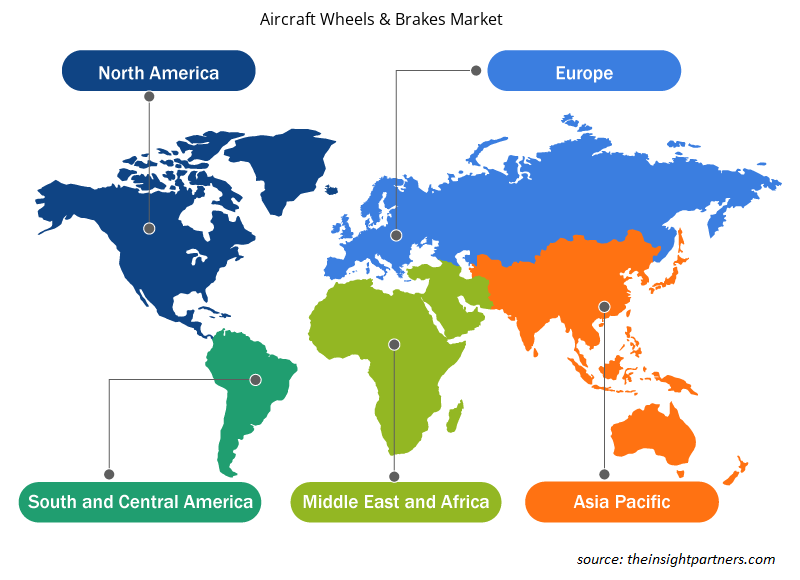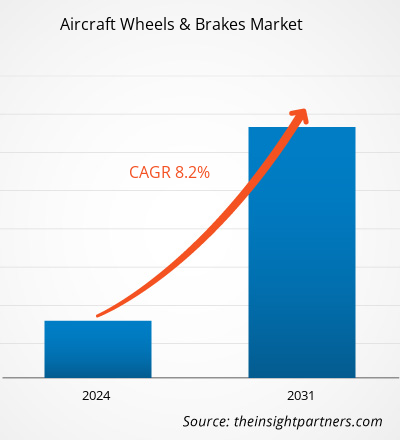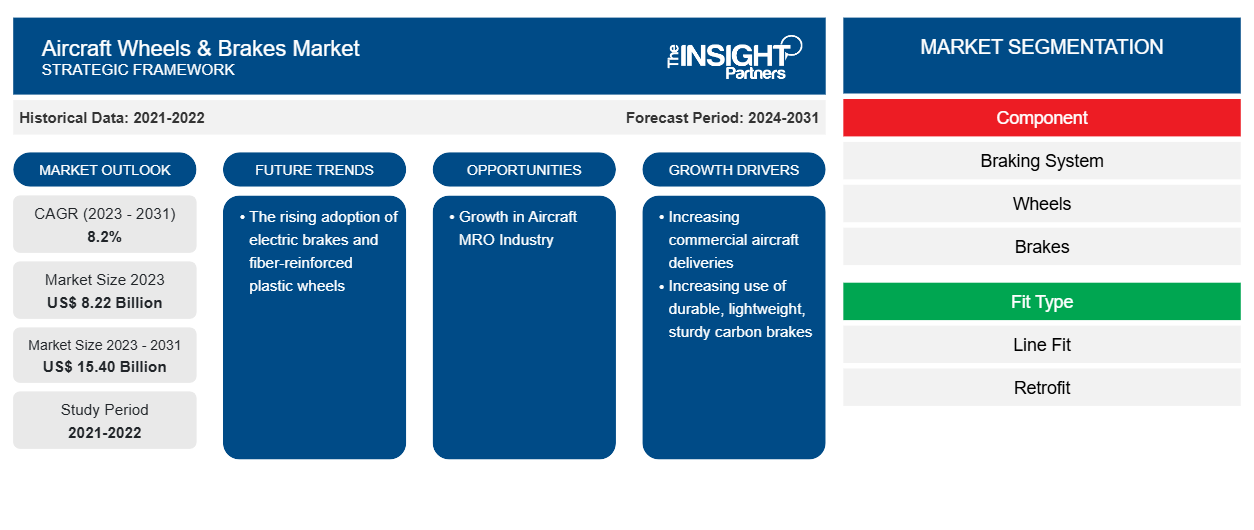Der Markt für Flugzeugräder und -bremsen soll von 8,22 Milliarden US-Dollar im Jahr 2023 auf 15,40 Milliarden US-Dollar im Jahr 2031 anwachsen. Der Markt wird zwischen 2023 und 2031 voraussichtlich eine durchschnittliche jährliche Wachstumsrate von 8,2 % verzeichnen. Die zunehmende Verbreitung von Elektrobremsen und faserverstärkten Kunststoffrädern dürfte ein wichtiger Trend auf dem Markt bleiben.
Marktanalyse für Flugzeugräder und -bremsen
Der Markt für Flugzeugräder und -bremsen wird größtenteils von etablierten Unternehmen wie Honeywell International Inc., Parker Hannifin Corporation, Safran Group und Crane Aerospace & Electronics dominiert. Die Nachfrage der Flugzeughersteller nach Rädern und Bremsen nimmt stark zu. Die meisten Aufträge werden jedoch an etablierte Unternehmen vergeben. Darüber hinaus muss die Herstellung dieser Räder und Bremsen mehrere von der zuständigen Behörde festgelegte Standards erfüllen. Dies erfordert den Erwerb verschiedener Zertifizierungen und erhebliche Investitionen in Forschung und Entwicklung, was den Eintritt neuer Unternehmen in das Feld einschränkt. Daher ist die Geschäftsbedrohung durch neue Marktteilnehmer im aktuellen Szenario hoch. Mit dem Anstieg des Flugzeugproduktionsvolumens ist jedoch mit dem Aufkommen neuer Unternehmen zu rechnen. Dies dürfte die Bedrohung für neue Marktteilnehmer verringern, da mehrere kleinere oder mittelgroße Flugzeughersteller ihre Räder und Bremsen von neuen Anbietern beziehen würden, die Räder und Bremsen mit fortschrittlicher Technologie zu einem wettbewerbsfähigen Preis anbieten.
Marktübersicht für Flugzeugräder und -bremsen
Das Ökosystem des Marktes für Flugzeugräder und -bremsen besteht aus folgenden Interessengruppen: Rohstoff- und Komponentenanbieter, Hersteller von Flugzeugrädern und -bremsen, Flugzeughersteller und Endverbraucher. Die Hersteller von Flugzeugrädern und -bremsen beschaffen Rohstoffe und Komponenten wie Stahl, Aluminium, Magnesiumlegierungen und Kohlenstofffaserwerkstoffe, und Komponenten wie Sensoren und Aktuatoren stammen von verschiedenen Rohstoff- und Komponentenanbietern. Hersteller von Flugzeugrädern und -bremsen montieren Rohstoffe und Komponenten und produzieren daraus Fertigprodukte. Die Hersteller von Flugzeugrädern und -bremsen arbeiten Hand in Hand mit Luftfahrtbehörden, Rohstofflieferanten, Flugzeugherstellern und den Endverbrauchern. Einige der führenden Akteure auf dem Markt sind unter anderem Collins Aerospace, Honeywell International Inc, Safran Group und Parker Hannifin Corporation. Darüber hinaus beschaffen die Flugzeughersteller Räder und Bremsen von den oben genannten Akteuren und installieren diese im Rahmen von Line-Fit-Aktivitäten in ihren Flugzeugflotten. Schließlich erwerben die Endverbraucher wie Fluggesellschaften, Streitkräfte verschiedener Länder und MRO-Dienstleister Verträge für MRO-Aktivitäten im Bereich Flugzeugräder und -bremsen. Die MRO-Dienstleister beschaffen kontinuierlich Räder und Bremsen von den Marktteilnehmern, um der stetig steigenden Nachfrage nach MRO für Flugzeugräder und -bremsen auch in Zukunft gerecht zu werden.
Passen Sie diesen Bericht Ihren Anforderungen an
Sie erhalten kostenlos individuelle Anpassungen an jedem Bericht, einschließlich Teilen dieses Berichts oder einer Analyse auf Länderebene, eines Excel-Datenpakets sowie tolle Angebote und Rabatte für Start-ups und Universitäten.
-
Holen Sie sich die wichtigsten Markttrends aus diesem Bericht.Dieses KOSTENLOSE Beispiel umfasst eine Datenanalyse von Markttrends bis hin zu Schätzungen und Prognosen.
Regionale Einblicke in den Markt für Flugzeugräder und -bremsen
Die regionalen Trends und Faktoren, die den Markt für Flugzeugräder und -bremsen im Prognosezeitraum beeinflussen, wurden von den Analysten von Insight Partners ausführlich erläutert. In diesem Abschnitt werden auch die Marktsegmente und die Geografie für Flugzeugräder und -bremsen in Nordamerika, Europa, im asiatisch-pazifischen Raum, im Nahen Osten und Afrika sowie in Süd- und Mittelamerika erörtert.

- Erhalten Sie regionale Daten zum Markt für Flugzeugräder und -bremsen
Umfang des Marktberichts zu Flugzeugrädern und -bremsen
| Berichtsattribut | Details |
|---|---|
| Marktgröße im Jahr 2023 | 8,22 Milliarden US-Dollar |
| Marktgröße bis 2031 | 15,40 Milliarden US-Dollar |
| Globale CAGR (2023 - 2031) | 8,2 % |
| Historische Daten | 2021-2022 |
| Prognosezeitraum | 2024–2031 |
| Abgedeckte Segmente |
Nach Komponente
|
| Abgedeckte Regionen und Länder |
Nordamerika
|
| Marktführer und wichtige Unternehmensprofile |
|
Marktteilnehmerdichte: Der Einfluss auf die Geschäftsdynamik
Der Markt für Flugzeugräder und -bremsen wächst rasant. Die Nachfrage der Endverbraucher steigt aufgrund von Faktoren wie sich entwickelnden Verbraucherpräferenzen, technologischen Fortschritten und einem größeren Bewusstsein für die Vorteile des Produkts. Mit der steigenden Nachfrage erweitern Unternehmen ihr Angebot, entwickeln Innovationen, um die Bedürfnisse der Verbraucher zu erfüllen, und nutzen neue Trends, was das Marktwachstum weiter ankurbelt.
Die Marktteilnehmerdichte bezieht sich auf die Verteilung der Firmen oder Unternehmen, die in einem bestimmten Markt oder einer bestimmten Branche tätig sind. Sie gibt an, wie viele Wettbewerber (Marktteilnehmer) in einem bestimmten Marktraum im Verhältnis zu seiner Größe oder seinem gesamten Marktwert präsent sind.
Die wichtigsten auf dem Markt für Flugzeugräder und -bremsen tätigen Unternehmen sind:
- Beringer Aero
- Collins Luft- und Raumfahrt
- Honeywell International Inc.
- Meggitt PLC
- Parker Hannifin Corporation
Haftungsausschluss : Die oben aufgeführten Unternehmen sind nicht in einer bestimmten Reihenfolge aufgeführt.

- Überblick über die wichtigsten Akteure auf dem Markt für Flugzeugräder und -bremsen
Marktnachrichten und aktuelle Entwicklungen zu Flugzeugrädern und -bremsen
Der Markt für Flugzeugräder und -bremsen wird durch die Erhebung qualitativer und quantitativer Daten nach Primär- und Sekundärforschung bewertet, die wichtige Unternehmensveröffentlichungen, Verbandsdaten und Datenbanken umfasst. Nachfolgend sind einige der Entwicklungen auf dem Markt für Flugzeugräder und -bremsen aufgeführt:
- Safran Landing Systems hat an seinem Standort Vélizy-Villacoublay (Frankreich) ein komplett neu gestaltetes Labor eingeweiht, das der Prüfung seiner Räder und Carbonbremsen gewidmet und mit einem neuen Prüfstand ausgestattet ist. Das Unternehmen wird insgesamt 10 Millionen Euro in die Umsetzung dieses ehrgeizigen Projekts investiert haben. Das Ergebnis ist ein verantwortungsvolles Arbeitsumfeld und das Versprechen, die Fähigkeit von Safran zu stärken, leistungsstärkere, langlebigere und wettbewerbsfähigere Bremsen zu entwickeln und zu qualifizieren sowie mit den Produktionsanläufen seiner Kunden Schritt zu halten. Dies gilt für fast alle Segmente der zivilen, militärischen und Geschäftsluftfahrt. (Quelle: Safran, Pressemitteilung, April 2024)
- Parker-Hannifin Corporation (NYSE: PH, „Parker“), der weltweit führende Anbieter von Bewegungs- und Steuerungstechnologien, gab heute bekannt, dass es die zuvor angekündigte Transaktion zum Verkauf seiner Aircraft Wheel and Brake Division mit Sitz in Avon, Ohio, in den USA, an Kaman Corporation (NYSE: KAMN) abgeschlossen hat. Kaman mit Hauptsitz in Bloomfield, Connecticut, ist ein führender Hersteller von Komponenten und Materialien für die Luft- und Raumfahrt sowie die Verteidigungs-, Industrie- und Medizinmärkte. (Quelle: Parker-Hannifin Corporation, Pressemitteilung, September 2022)
Marktbericht zu Flugzeugrädern und -bremsen – Umfang und Ergebnisse
Der Bericht „Marktgröße und Prognose für Flugzeugräder und -bremsen (2021–2031)“ bietet eine detaillierte Analyse des Marktes, die die folgenden Bereiche abdeckt:
- Marktgröße und Prognose für Flugzeugräder und -bremsen auf globaler, regionaler und Länderebene für alle wichtigen Marktsegmente, die im Rahmen des Berichts abgedeckt sind
- Markttrends und Marktdynamiken für Flugzeugräder und -bremsen wie Treiber, Einschränkungen und wichtige Chancen
- Detaillierte Porter-Fünf-Kräfte-Analyse
- Marktanalyse für Flugzeugräder und -bremsen, die wichtige Markttrends, globale und regionale Rahmenbedingungen, wichtige Akteure, Vorschriften und aktuelle Marktentwicklungen umfasst
- Branchenlandschaft und Wettbewerbsanalyse, die die Marktkonzentration, Heatmap-Analyse, prominente Akteure und aktuelle Entwicklungen auf dem Markt für Flugzeugräder und -bremsen umfasst
- Detaillierte Firmenprofile
- Historische Analyse (2 Jahre), Basisjahr, Prognose (7 Jahre) mit CAGR
- PEST- und SWOT-Analyse
- Marktgröße Wert/Volumen – Global, Regional, Land
- Branchen- und Wettbewerbslandschaft
- Excel-Datensatz
Aktuelle Berichte
Verwandte Berichte
Erfahrungsberichte
Grund zum Kauf
- Fundierte Entscheidungsfindung
- Marktdynamik verstehen
- Wettbewerbsanalyse
- Kundeneinblicke
- Marktprognosen
- Risikominimierung
- Strategische Planung
- Investitionsbegründung
- Identifizierung neuer Märkte
- Verbesserung von Marketingstrategien
- Steigerung der Betriebseffizienz
- Anpassung an regulatorische Trends























 Kostenlose Probe anfordern für - Markt für Flugzeugräder und -bremsen
Kostenlose Probe anfordern für - Markt für Flugzeugräder und -bremsen